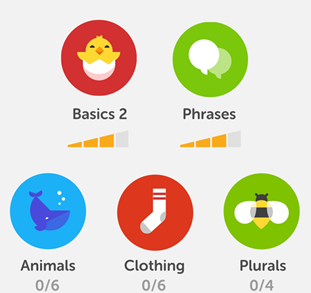Duolingo is an app that helps users to develop and improve their language skills through everyday training. Language exercises are pretty simple on the first levels, so users can gradually move forward and eventually acquire sound grammar skills for any of the 38 languages available. Duolingo was invented in 2009 by Luis von Ahn as a tool for people who cannot afford expensive learning courses. Luis von Ahn is a co-founder and CEO of Duolingo and reCAPTCHA and a computer science professor at Carnegie Mellon University. Today the app has 150 million users worldwide and is valued at $ 1.5 billion (Munday 194). This paper aims to analyze the app’s functions, usability, relevance, and relatability.
App Functions
The app’s primary function is learning the language, which is performed in the form of exercises. There is a ‘tree’ of learning that divides the exercises into levels depending on the grammar complexity and vocabulary topics. The users cannot move to harder levels before completing the easier ones. There are also three main types of exercises – translating L2 (second language) to L1 (mother language), translating L1 to L2, and matching the words in L1 and L2 (Munday 194). Translation exercises usually include prompts and the underlined words in L2 that provide immediate translation when the user has to translate the whole sentence from L2 to L1 or vice versa.

App Usability
The Duolingo app has high usability and gains positive feedback among users all over the world. According to the research, “85.13% of the users rated the tool with the highest score” and mentioned that the app’s usability “is a positive component that facilitates learning” (De Araújo and Eddine 5). Since the application developers’ original goal and mission was to make the learning fun and accessible, the application uses only the basic elements of usability, such as listening to the voice-over and using the microphone in audio-based steps of the exercises. If the users have no opportunity to use the microphone, there is an option to exclude this feature. Noteworthy, the app has a good user-learning relationship and provides helpful feedback during the learning process.
The Relevance of the Duolingo App
This app was developed to meet the needs of people who study a foreign language. Since the app was initially developed and remains 100% free, it has a vast public of users, up to 150 million people (Munday 194). According to the research, most users who study through this app show improved learning results (Loewen 293). Luis von Ahn, the developer, said that the main purpose of the app was to give the opportunity of free and high-quality learning to almost 1.2 billion people who need the opportunity to learn a language (“The History of Duolingo”). Luis von Ahn said in an interview: “In fact, the reason they are learning a language is to be able to get a better job or a job at all” (“The History of Duolingo”). Therefore, this app gained popularity very quickly as it covered a previously unaddressed segment of the market – people who needed to learn a language but were not wealthy enough to pay for courses or buy expensive licensed programs.


The Relatability of the Duolingo App
The app’s main function is learning the foreign language, even though it uses additional features to improve the relatability, like inviting friends or exchanging the lingots to Mr. Owl’s outfits. The motivation to learn is generally integrated into the exercises through gamification. There is also an element of competition when users can see their success compared to other users and reach top positions in the bronze, silver, and golden leagues.
Thus, the Duolingo app’s functions, usability, relevance, and relatability were analyzed. It has a developed system of exercises that motivate the learners to move forward gradually. Experts approve that the app has good usability and relatability ensured by learning in the form of games. The app is highly relevant for learners worldwide who study foreign languages to get a better job and improve their living.
Works Cited
De Araújo, Patrick Anderson Matias, and Eder Ahmad Charaf Eddine. “The Review of Users of the Duolingo Application Usability and Objectivity in the Learning Process.” International Journal of Research-GRANTHAALAYAH 8.9 (2020): 5-15.
Loewen, Shawn, et al. “Mobile-assisted language learning: A Duolingo case study.” ReCALL: The Journal of EUROCALL 31.3 (2019): 293-311.
Munday, Pilar. “Duolingo. Gamified learning through translation.” Journal of Spanish Language Teaching 4.2 (2017): 194-198.
“The History of Duolingo.”Huffington Post, 2017, Web.